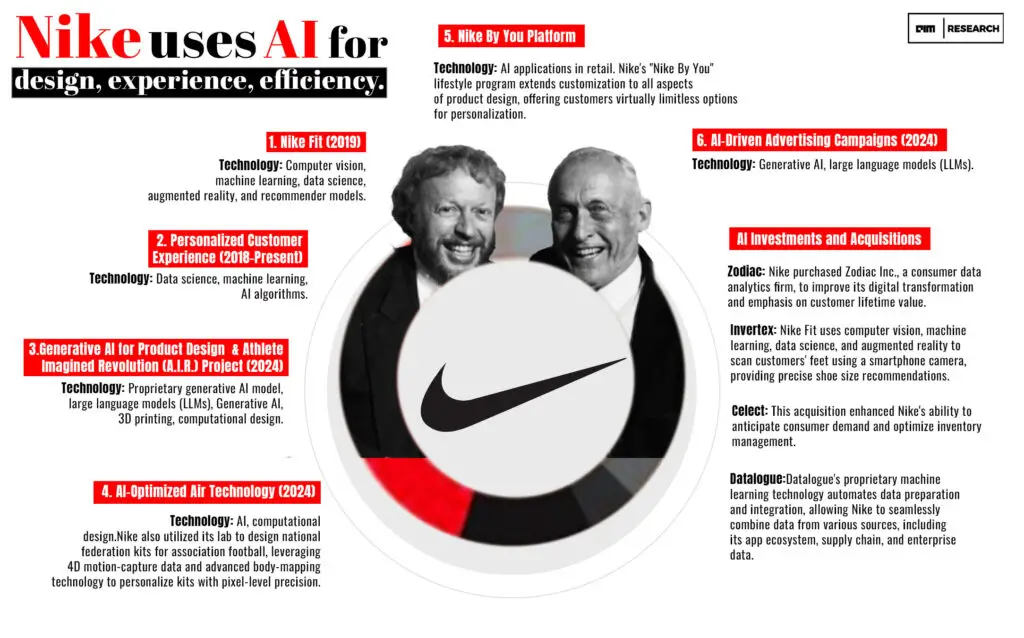AI in Product Development: Benefits, Essential Use Cases, and Challenges

In today’s world, it is evident that emerging technologies like AI and ML play an important role in enhancing product development. AI-based product development is commonly believed to help companies design better products by helping them build products faster.
AI technologies are changing the way companies develop, produce, and promote their goods. It is projected that the worldwide AI market will develop at a rate of 37.3% from 2023 to 2030, reaching a value of $1.8 trillion.
AI will have a bigger influence on entrepreneurs’ product development as it develops. Brands can create distinctive items that surpass consumer expectations, obtain a competitive edge, and stimulate more innovation by utilizing AI capabilities.
In this blog post, we look at how entrepreneurs may use AI to create better products and enhance overall operations, as well as what the future holds for those who effectively implement AI in product creation.
A Glimpse of AI into Product Development
AI is transforming the product development landscape in an age of mainstream innovation. AI-powered tools and technologies allow businesses to design, develop, and launch products with unprecedented speed and scope.
Integrating AI into product development has positively impacted the world by changing how businesses bring forth and improve their products.
Excellent capabilities of using enhanced algorithms and different types of machine learning help analyze customer patterns more thoroughly, fine-tune the design process, and predict market trends accurately.

(Source: AIM Research)
- For example, Nike has been harnessing the power of data analysis through artificial intelligence to improve its product development process.
- Nike can predict new requirements using information obtained from customers’ feedback, purchasing behaviors, and active social media content.
- Such orientation helps advance the development process and makes new products more congruent with consumers’ demands, resulting in greater satisfaction and sales.
Another inspiring example is the automotive industry, where AI tools and applications are gradually infiltrating.
- Tesla’s integrated design and manufacturing strategy includes using AI in its products.
- Additionally, the firm employs machine learning algorithms to process driving data, enabling fine-tuning of various car attributes and enhancing safety features.
- This allows Tesla to incrementally improve the software and the hardware used in its vehicles and, hence, keep up with the latest trends.
From research and design to production, implementation, and distribution, Tesla’s integration of AI into the product development process improves vehicle performance and advances technological progress in the automobile industry.
How does AI in Product Development Work?
AI in product development means a systematic and even rigorous task that implies using specific equipment in each process step. This section describes the main parts and operations that support building AI-based products and services, from input data to effectuation.
Data Sources
The practical application of AI involves utilizing various forms of data for insights and decision-making. These include:
- 1. Internal Data: Data collected from company databases, clients’ feedback, and sales figures.
- 2. External Data: Marketing insights, public mood analysis, and direct competitor intelligence.
- 3. Sensor Data: User feedback and data gathered from the IoT-connected products used during testing.
Data Pipeline
The data pipeline is essential for transforming raw data into actionable insights:
- 1. Data collection: Collect data from different sources through APIs and web scraping techniques.
- 2. Data Integration: Consolidates data from various sources into a standard format by performing three primary operations, namely, extraction, transformation, and loading.
- 3. Data Cleaning: Data cleaning involves preprocessing the raw data to eliminate unwanted elements, manage missing values, and attain uniformity.
APIs and Plugins
APIs and plugins facilitate the seamless integration of AI tools into the product development workflow:
- 1. APIs (Application Programming Interfaces): Let there be API calls for the AI models to engage other systems like databases, the cloud, and third-party analytical tools.
- 2. Plugins: Extend the capabilities of current software with new AI features like prescriptive analytics or voice recognition.
Orchestration Layer
The orchestration layer coordinates and manages the execution of various AI components:
- 1. Workflow management: This involves controlling processes carried out in its pipeline and managing their execution to perform activities in the correct order at appropriate time intervals.
- 2. Resource Allocation: This function controls and allocates the processing resources, including the CPU and the GPU, for efficiency and capability.
Execution
Execution involves running AI models and applying them to product development tasks. To build an AI model successfully, execution is key:
- 1. Model training: Involves feeding past data into the machine learning programs to help them learn and identify patterns for future analysis.
- 2. Model deployment: Incorporates trained models into the product development environment for online usage and execution.
- 3. Real-time Analytics: AI models are used on live data feeds for real-time learning and analytics to help decision-making.
Feedback Loop
The feedback loop is essential for continuous improvement:
- 1. Performance Monitoring involves monitoring AI models and algorithms to determine their accuracy and relevance.
- 2. Model Updating: Updates models with new data and emerging insights to fine-tune its forecasts and proactively suggest changes.
Integration with AI Tools
AI tools are integrated with existing development platforms and software:
- 1. Design Tools: AI-integrated design applications streamline work and can propose layouts and features independently.
- 2. Project Management Tools: AI insights assist with resource management and scheduling and identify potential risks and dangers encountered in the project.
Deployment and Maintenance
Post-development, AI systems are deployed and maintained to ensure ongoing effectiveness:
- 1. Deployment: AI solutions are released into the product mode and deployed in cloud environments due to their flexibility.
- 2. Maintenance: AI models are updated and patched frequently to ensure they remain relevant and reflect the current data and trends.
These technical aspects facilitate the increased use of AI in product development, thus improving its efficiency in developing new products and enhancing innovation through the on-time delivery of better products.
Do You Want to Integrate AI Technology In Your Product?
Bring your vision to life with our AI-powered product development.
Contact us for high-quality solutions that grow with your business.
Benefits of AI-powered Product Development
As a product developer or product head, using AI throughout the development process will offer many benefits, such as:
Enhanced Security
With AI, developers and product managers can easily integrate robust AI techniques such as Captcha, facial recognition, and other emerging features that enhance customer experience, boost security, and prevent cyberattacks or other threats.
Improved Product Quality
Artificial intelligence (AI) algorithms can examine usage data, customer reviews, and other pertinent data sources to find problems with current goods and provide fixes.
Businesses may detect design defects early in the development process and make the required adjustments to ensure that the finished product fulfills customer expectations by implementing AI. Higher product quality and more client happiness are the results of this.
Process Optimization
AI has many capabilities, such as managing a massive volume of data, identifying patterns, and making operations more efficient.
AI also helps product designers speed up prototype development and wireframing, speeding up the overall product development process. AI-powered solutions also enable real-time sharing of suggestions, making tasks less complicated and time-consuming.
Enable Personalization
AI can enable personalization by adapting your products to users’ requirements and preferences. For instance, AI can personalize your product’s features, content, and interface, creating a distinctive and captivating user experience.
AI can also be used to segment your user base, forecast their behavior, and offer relevant advice, criticism, and assistance – all of which will help you cultivate a devoted and contented clientele. Using AI, you can differentiate your product from the competition and develop one that connects with your users.
Informed Decision Making
According to the leading research partner, McKinsey, in the next five years, most businesses will have implemented AI in their daily operations, and large corporations will have fully integrated unique AI solutions to automate mundane tasks and boost productivity.
With such tremendous potential, AI can analyze vast raw data in a structured format, allowing entrepreneurs to make informed decisions whenever required while opening doors to many future possibilities.
Technologies and Tools that Foster AI Integration Process
Below are the tools and technologies used in the AI-powered product development process.
- TensorFlow: Google has launched a machine learning and deep learning software framework.
- PyTorch: A most used machine learning library with dynamic computation graphs created by the Facebook Artificial Intelligence Research (FAIR) team.
- Keras: A beginner-friendly neural networks deep learning library with Python developed to run TensorFlow.
- Scikit-learn: In simple terms, it is an ML library written in Python with the balance of ease of usage and efficiency for data mining and analysis.
- Apache Spark: An open-source computing system for large-scale data processing with associated components for machine learning.
- Microsoft Azure: AI deals with a set of services and tools for cloud AI that provide numerous features such as machine learning and cognitive services.
- Google Cloud AI: A list of readymade AI and machine learning products and services offered by Google Cloud, as well as an opportunity to train models individually.
- IBM Watson: A group of AI tools and services that includes natural language processing and machine learning.
- Transformers: An open-source library developed and maintained by Hugging Face that offers pre-trained models and utilities for NLP.
- RapidMiner: An integrated data analysis tool that consists of tools for machine learning, data mining, and business intelligence.
- DataRobot: This MLOps tool enables the development of machine learning models without much coding.
- Apache Mahout: Mahout, a machine learning library, is programmed to handle big data and accomplish various operations such as classification, clustering, and recommendations.
The tools mentioned above and technologies play an essential role in developing AI-integrated products, each coming up with unique offerings and capabilities to enhance the product development process.
5 AI Use Cases for Product Development
AI is changing product development by improving efficiency and innovation. Here are five crucial AI applications that are changing product design and development processes:
Market Research and Insights
AI’s cognitive abilities include analyzing big data, including trends, customer preferences, and competition. This helps companies be in a position to make the right decisions and come up with new products that meet new needs.
Design and Prototyping
Generative design requires AI to create new, efficient designs for products. AI enables the speedy sampling of many design variations in the shortest time possible and comes in handy in optimizing the design based on simulation studies.
Personalization and Customization
This ensures that the right product is recommended to a specific customer or that part of the product needs to be tailored to a particular client. Businesses today increasingly build AI recommendation systems to enhance this process, improving consumer satisfaction and value by providing goods selected based on customer characteristics.
Predictive Maintenance
AI systems alert users of probable equipment breakdowns in manufacturing before such incidents happen. It is a preventative measure that reduces time losses and prolongs the working life of machinery, contributing to more predictable manufacturing operations.
Quality Assurance and Testing
AI helps to automate quality assurance by identifying areas of weakness or imperfections in product testing. Implementing them allows us to detect problems and find solutions faster and more efficiently because machines have better algorithms for pattern recognition than humans.
Obstacles that Product Managers Have to Overcome in AI Product Design
AI product development comes with several challenges that are different from conventional products. Below are some of the major challenges that are experienced by the product managers in this dynamic industry.
Data Quality and Management
The foundation of success in implementing AI models depends on the quality of data that they employ. Some challenges that need to be faced by product managers are associated with data acquisition and preparation, as well as the elimination of biases and inaccuracies.
Ethical and Privacy Concerns
AI products should follow ethical standards and legal frameworks concerning privacy. The problem that product managers experience is that they need to innovate and offer additional features that, however, need to be as cautious as possible when it comes to data usage and obtaining consent from the users.
Integration with Existing Systems
Getting AI solutions to fit into the existing infrastructure seamlessly may prove to be difficult. Product managers must achieve compatibility and maintain their operations with internal systems while being able to consider and cope with disruptions at the same time.
Talent Acquisition and Retention
The talent battle for AI workers is intensifying, and attracting and keeping them is a growing concern. AI success in product management depends on talent acquisition and maintaining a positive working relationship.
Rapid Technological Advancements
The growth of AI technology has been very rapid, and this can act as a hurdle and make it hard to update. The development of information and communication technologies means that product managers ought to expand their information and skills bases and use them to drive change optimally.
Guru TechnoLabs Approach to AI-powered Product Development
At Guru TechnoLabs, our AI-powered product development follows a streamlined, technical approach to ensure innovative and effective solutions:
- Project scope, goals, and success factors are identified by conducting a thorough analysis of the project and the market.
- Our team ideates and iterates, always centering on addressing certain challenges through the use of AI features and data.
- In this approach, we develop an MVP to test ideas fast, and the product will contain all the fundamental aspects and primary AI components.
- Following the agile approaches, the product is collaboratively evolved and improved with feedback for better performance.
- The testing mainly done here has them pass through unit testing, integration testing, and user acceptance to ensure the quality and integrity of the product are not compromised.
- The product is deployed effectively and the functionality is closely observed and tweaked if necessary to accomplish the intended purpose.
- After the product’s release, we make modifications and updates in the light of customers’ experience and the development of methods in AI technology.
This approach facilitates the development of products with AI that are both novel and quality, thus poised to be realized by Guru TechnoLabs.
Custom AI-Powered Product Development for Your Business
Unlock the potential of AI with a product tailored to your specific needs.
Partner with Guru TechnoLabs to create innovative solutions.
Final Thoughts
AI is changing how product managers develop products, which won’t change anytime soon. With over 86% of decision-makers saying that AI is central to their business operations, AI product development is here to stay. Contact us if you have not implemented it yet but are planning to leverage its capabilities. We help you build ideal products that maintain alignment across the product and unify your business operations.
Frequently Asked Questions
AI is upscaling product development by automating mundane tasks, analyzing massive raw data, streamlining decision-making, and allowing predictive capabilities.
Artificial intelligence (AI) can drastically shorten the time it takes to develop a new product by automating processes, speeding up data processing, and facilitating quick prototyping. Faster product testing, iterations, and refinement are made possible by this.
While incorporating AI has many advantages, not all businesses may need to. The choice should be made in light of the particular requirements and objectives of the company and the possible benefits AI may have for developing new products.
When choosing developers or product development companies, a few elements like experience, commitment, expertise, and other essential elements should be considered.















